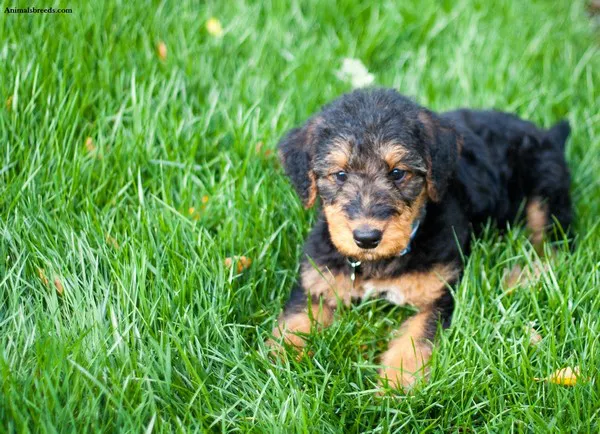Embarking on the journey of raising an Airedale Terrier puppy involves instilling positive behaviors, and one common challenge is addressing biting tendencies. This comprehensive guide is designed to provide Airedale Terrier owners with effective strategies to train their puppies to stop biting. From understanding the root causes to implementing gentle training techniques, we delve into the intricacies of fostering a nurturing relationship while curbing undesirable biting behaviors.
Understanding Airedale Terrier Puppy Behavior
Before delving into the specifics of bite training, it’s crucial to comprehend Airedale Terrier puppy behavior. Puppies, including Airedales, explore the world through their mouths. Biting is a natural part of their development, but it’s essential to guide this behavior toward acceptable alternatives. Recognizing the cues that precede biting episodes and understanding the underlying reasons set the stage for effective training.
Establishing Boundaries
Setting clear boundaries is fundamental in training an Airedale Terrier puppy to stop biting. Puppies thrive on routine and consistency, so establishing rules from the outset is crucial. Clearly communicate that biting is unacceptable by redirecting their attention to appropriate chew toys. Consistency in enforcing boundaries helps your Airedale Terrier puppy understand what behavior is expected and fosters a positive learning environment.
Positive Reinforcement Techniques
Positive reinforcement is a powerful tool in Airedale Terrier puppy training. When your puppy engages in gentle play without biting, immediately reward them with praise, treats, or affection. Positive reinforcement reinforces the idea that not biting results in positive outcomes, encouraging your Airedale Terrier to opt for gentle interactions. Consistency in rewarding desirable behavior enhances the effectiveness of this training approach.
Interactive Play
Interactive play is a crucial aspect of Airedale Terrier puppy development, and incorporating it into training can redirect biting tendencies. Engage in interactive play using appropriate toys that encourage chewing and gnawing. This not only satisfies their natural instincts but also provides an acceptable outlet for their need to bite. Channeling their energy into constructive play diminishes the likelihood of biting during interactions.
Bite Inhibition Training
Bite inhibition training is a cornerstone in curbing biting behavior in Airedale Terrier puppies. This involves teaching them to control the force of their bite, so if they do nip, it’s gentle rather than painful. During play, if your puppy bites too hard, emit a high-pitched yelp to mimic a puppy in distress. This signals to your Airedale Terrier that their bite was too strong, and they should adjust their mouthing pressure. Over time, they learn to mouth more gently to avoid causing discomfort.
Consistent Socialization
Socialization plays a pivotal role in Airedale Terrier puppy training, including addressing biting behavior. Expose your puppy to various people, environments, and other dogs in a controlled manner. Positive social experiences contribute to a well-adjusted puppy less prone to anxiety-driven biting. Airedale Terriers thrive on social interactions, and a well-socialized puppy is more likely to engage in gentle play rather than resorting to biting as a stress response.
Redirecting Attention
When your Airedale Terrier puppy exhibits biting behavior, redirect their attention to appropriate alternatives. Keep a selection of chew toys readily available and encourage them to focus on these instead of biting hands or clothing. Consistent redirection teaches your puppy that there are acceptable outlets for their biting instincts, fostering a positive association with alternative chewing options.
Avoiding Rough Play
While play is essential for Airedale Terrier puppy development, it’s crucial to avoid overly rough play that may trigger biting. If your puppy becomes too excited and starts to bite, take a brief break from playtime. This teaches them that biting results in the cessation of enjoyable activities. Gradually reintroduce play, reinforcing the message that gentle play is rewarded while biting interrupts the fun.
Understanding Teething
Teething is a natural phase in an Airedale Terrier puppy’s life and can contribute to increased biting tendencies. Understand that teething may cause discomfort, making your puppy more inclined to chew and bite. Provide appropriate teething toys to soothe their gums and alleviate discomfort. Patience during this phase is essential, as consistent training coupled with appropriate teething outlets helps your Airedale Terrier navigate this developmental stage.
Consistency in Training
Consistency is paramount in training an Airedale Terrier puppy to stop biting. Regularly revisit training techniques, reinforce positive behaviors, and address any setbacks promptly. Consistent reinforcement of expectations and positive interactions fosters long-term behavior patterns. Whether during play or daily interactions, maintaining a consistent approach to training contributes to a well-behaved Airedale Terrier.
Professional Training Assistance
If you encounter persistent challenges in training your Airedale Terrier puppy to stop biting, seeking professional guidance can be invaluable. Professional trainers possess expertise in canine behavior and can offer tailored strategies for your specific situation. A professional assessment ensures that training approaches align with your puppy’s unique needs, providing effective solutions to address biting behavior.
Conclusion
In conclusion, training your Airedale Terrier puppy to stop biting involves a holistic approach that prioritizes positive reinforcement, consistent boundaries, and understanding your puppy’s developmental needs. By incorporating interactive play, bite inhibition training, and redirecting attention, you cultivate a nurturing environment for your Airedale Terrier to thrive. Patience, consistency, and a commitment to positive training techniques contribute to a lifelong bond built on trust and gentle companionship.


